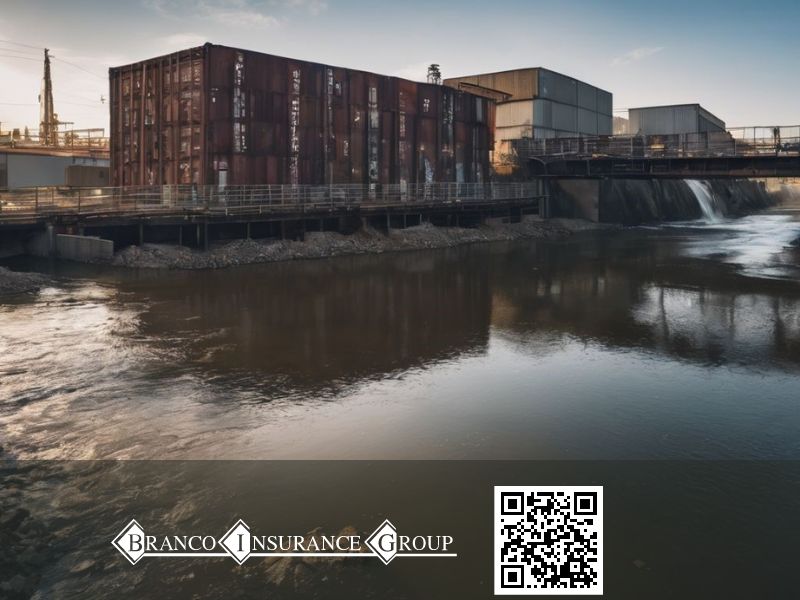
Mental Health Awareness Month: Prioritize the Mind, Support the Heart
May is Mental Health Awareness Month, a time to reflect on the importance of emotional well-being and the invisible battles many face daily. At Branco

Is your business adequately covered for environmental accidents? You’ll be surprised to learn that the environmental liability insurance market is worth approximately $2 billion in annual premiums.
This blog post will guide you through what Environmental Liability Insurance entails and show how it can protect your business from substantial financial losses due to pollution-related damages.
Now, let’s dive in and explore this significant aspect of risk management!
Environmental Liability Insurance is a type of insurance that provides coverage for loss or damages resulting from pollution-related incidents.
Environmental liability insurance is a type of coverage. It pays for damages or losses due to pollutants. These harmful items are often left out of normal insurance plans. This plan takes care of costs when pollution hurts property or people.
For example, an oil spill at work could lead to soil and water damage, or dangerous chemicals might make people ill. Through this insurance, businesses can handle these tough situations without paying too much money out-of-pocket.
Environmental insurance can help a business when unexpected pollutants cause harm. This can damage people’s health or property. Many times, general liability insurance ignores these problems.
So, environmental insurance covers this gap.
Damage from pollution can happen to any business at any time. Environmental insurance protects companies from the costs of these shocks. The policy takes care of the hurt caused by a pollution event.
It also pays for cleaning up and restoring places harmed by pollutants.
Environmental Liability Insurance is crucial for businesses and industries as it provides protection against property loss, liability, bodily injury, and pollution cleanup costs resulting from environmental accidents or pollution-related damages.
Environmental Liability Insurance is a key tool for you. It keeps your property safe from harm caused by pollution. A harmful spill on your land could cost thousands of dollars to clean up.
This insurance will pay that bill. Plus, if someone else’s place gets damaged because of your accident, they might take you to court. This policy covers the legal costs and pays for their loss, too! So, it shields you from big bills and lawsuits tied to environmental damage.
Environmental liability insurance provides coverage for bodily injury and pollution cleanup costs. This means that if there is an accident or incident that causes harm to individuals due to pollution, such as toxic waste materials, the insurance policy can help cover the expenses related to medical treatment and rehabilitation for the injured parties.
Additionally, in case of contamination or pollution events, where hazardous or non-hazardous materials have been released into the environment and require cleanup, environmental liability insurance can also provide financial support for those cleanup costs.
By having this coverage in place, businesses can protect themselves from potential lawsuits and ensure that they are able to take action quickly to mitigate any damage caused by their operations.
There are three main types of environmental liability insurance: pollution liability insurance, environmental impairment liability insurance, and contractor’s pollution liability insurance.
Pollution Liability Insurance is a type of environmental insurance that provides coverage for unexpected pollutants that are typically excluded in general liability insurance. It helps protect businesses when pollution-related situations occur, covering costs associated with pollution cleanup, restoration, and legal liabilities arising from pollution events.
This type of insurance is especially important for companies involved in manufacturing, construction, transportation, and waste management, which may be at higher risk for pollution incidents.
With Pollution Liability Insurance, businesses can have the financial protection they need to handle the costs and responsibilities associated with the environmental damage caused by their operations.
Environmental Impairment Liability Insurance, also known as EIL insurance, provides coverage for unknown pre-existing and future environmental liabilities. It is specifically designed to cover property loss and liability arising from pollution-related damages for sites owned by property owners.
With this insurance, you can customize your coverage to include claims related to environmental cleanup costs required by third parties. This type of insurance can be beneficial for businesses that handle hazardous materials or operate in industries prone to environmental risks.
A reputable insurance company like AIG offers Environmental Impairment Liability Insurance along with other types of environmental liability coverage to help protect against the financial consequences of pollution accidents, such as bodily injury, property damage, and cleanup costs.
Contractors Pollution Liability Insurance, also known as CPL insurance, is a type of environmental liability insurance that offers protection for contractors against pollution-related risks.
It specifically provides coverage for claims arising from pollution conditions caused by contractors’ operations. With CPL insurance, contractors can be protected from potential liabilities and financial losses associated with pollution-related claims.
This type of insurance is essential for contractors who are exposed to construction pollution risks or handle hazardous materials. By obtaining CPL insurance, contractors can ensure they are adequately covered and have peace of mind knowing they are protected against pollution-related liabilities and claims.
Environmental liability insurance provides coverage for a range of risks, including property damage, bodily injury, and pollution cleanup costs. It offers financial protection in case of unexpected pollution exposures or environmental accidents, ensuring that businesses can mitigate potential losses and fulfill their obligations under environmental regulations.
Environmental liability insurance provides coverage for property damage caused by pollution incidents. This means that if your business accidentally causes pollution that leads to property damage, the insurance can help cover the costs of repairing or replacing the damaged property.
For example, if there’s an oil spill on your company’s premises and it damages neighboring properties, environmental liability insurance can compensate the affected parties for their property damage.
It’s important to have this coverage in place because property damage claims can be costly, and having insurance helps protect your business financially in such situations.
Bodily injury is an important aspect of environmental liability insurance. This type of coverage protects individuals and businesses against legal liability for injuries caused by pollution conditions.
In the event of a pollution incident that results in bodily injuries, such as exposure to harmful chemicals or contamination, this insurance will cover the costs associated with medical expenses and any resulting lawsuits from third-party claims.
It ensures that businesses are protected financially and can afford to provide compensation for any harm caused by their activities. Having this coverage is especially crucial for industries prone to environmental risks or those handling hazardous materials.
Environmental liability insurance provides coverage for cleanup costs associated with pollution or environmental damage. This means that if there is an incident resulting in contamination of soil, water, or air, the policy will help cover the expenses involved in cleaning up and restoring the affected area.
Whether it’s a chemical leak, oil spill, or any other pollution-related incident, having this insurance can provide financial assistance to address the necessary cleanup and restoration expenses.
It’s important to remember that different types of environmental insurance policies exist to cover these cleanup costs and remediation expenses incurred due to environmental incidents.
Industries prone to environmental risks and businesses handling hazardous materials should consider obtaining environmental liability insurance. Read on to learn more about the importance of this coverage and how it can protect your business.
Industries that are prone to environmental risks include:
Companies that handle hazardous materials are particularly at risk for potential environmental liability issues. These businesses need to protect themselves by investing in environmental liability insurance, which provides coverage for unexpected pollutants and contaminants. Some examples of these hazardous materials include toxic substances, pollutants, hazardous waste, asbestos, and contamination. By obtaining environmental liability insurance, these businesses can mitigate their financial risks and ensure compliance with environmental regulations.
Assess your business risks, evaluate coverage options, and seek guidance from an insurance professional to ensure proper protection. Explore more about choosing the right environmental liability insurance here!
Assessing the specific risks of your business is an important step when choosing environmental liability insurance. It helps you understand the potential environmental exposures your business may face and determine the level of coverage needed to protect against those risks.
This assessment involves gathering information about your operations, such as the types of hazardous materials you handle or any potential pollution risks. By evaluating these factors, you can identify and mitigate potential liabilities that could arise from accidents like accidental spills or contamination.
Insurance brokers and risk management professionals are valuable resources in this process, as they can help you assess your specific environmental risks and recommend appropriate insurance solutions based on their expertise.
When choosing the right environmental liability insurance, it is important to evaluate the coverage options and limits. This means looking beyond just the cost of the policy and considering factors like property damage, bodily injury coverage, and cleanup costs.
Agents and brokers should review the actual policy forms and endorsements to understand what is included in the coverage. Additionally, it’s crucial to assess your specific business risks before making a decision.
Remember that the cost of pollution liability insurance can vary based on different factors. By carefully evaluating coverage options and limits, you can ensure that you have adequate protection for potential environmental risks.
If you’re thinking about getting environmental liability insurance, it’s a good idea to seek guidance from an insurance professional. They can help you navigate the application process and find the right policy for your business.
Independent insurance agents, like those at Beacon Hill Associates, have expertise in this area and can provide valuable advice on choosing the right coverage options and limits. With their assistance, you can ensure that your business is adequately protected against environmental risks and avoid any costly mistakes.
Oil spills, chemical leaks, and soil contamination are all examples of environmental liability insurance claims. These incidents can result in property damage, bodily injury, and the need for costly pollution cleanup efforts.
Environmental liability insurance provides coverage for these potential risks and helps businesses mitigate financial losses associated with environmental accidents.
Oil spills can have devastating impacts on the environment, causing pollution and damage to ecosystems. They often occur in coastal areas where oil tankers or offshore drilling accidents can release large amounts of oil into the water.
Oil spills harm not only marine life but also affect nearby shorelines, leading to contamination and the need for costly cleanup efforts. The responsible party for an oil spill is liable under the Oil Pollution Act of 1990, which established a liability cap of $75 million for economic damages caused by such incidents.
It’s important for businesses in industries prone to environmental risks, like the oil industry, to have environmental liability insurance to protect themselves financially from potential liabilities resulting from oil spills and ensure compliance with environmental regulations.
Chemical leaks can be a serious issue, especially in refineries and chemical plants. These leaks can result in environmental damage and pose health risks to people living nearby. Environmental liability insurance provides coverage for loss or damages caused by unexpected pollutants like toxic spills and contaminations from hazardous substances.
It helps protect businesses from the financial consequences of these incidents and ensures that they are able to handle the cleanup costs properly. In fact, there have been claims made on environmental liability insurance due to chemical leaks in the past.
So, if your business deals with chemicals or operates in industries prone to such risks, it’s important to consider getting environmental liability insurance as part of your risk management strategy.
Soil contamination is a serious issue that can lead to environmental damage and legal and financial risks. It occurs when the soil becomes polluted or contaminated with hazardous substances, such as chemicals or toxins.
Examples of soil contamination include finding contaminated soil instead of clean soil used to fill a space where an underground storage tank leaked. Environmental liability insurance can help businesses protect themselves against these risks by providing coverage for property loss, liability, and cleanup costs associated with soil contamination.
It plays a crucial role in managing the risks associated with pollution-related issues, ensuring compliance with environmental regulations, and mitigating financial losses.
Environmental Liability Insurance plays a crucial role in risk management by mitigating financial losses and ensuring compliance with environmental regulations.
Environmental Liability Insurance plays a crucial role in mitigating financial losses associated with environmental liabilities. When accidents occur, such as pollution incidents or property damage caused by hazardous materials, the costs can be significant.
However, with the right insurance coverage in place, businesses can minimize their financial risks and protect themselves from potentially devastating expenses. Environmental Liability Insurance covers a range of potential losses, including bodily injury claims, property damage claims, and cleanup costs.
By having this insurance in place, companies can ensure that they have the necessary funds to address these issues without jeopardizing their financial stability.
Overall, Environmental Liability Insurance acts as a safety net for businesses facing environmental risks. It provides peace of mind knowing that if an accident occurs or a claim is made against them due to pollution-related damages, they will have the support they need to cover any financial losses.
This risk management tool not only protects businesses but also ensures compliance with environmental regulations and promotes responsible practices within industries prone to pollution risks.
To ensure compliance with environmental regulations, it is crucial for businesses to evaluate their environmental exposures and associated insurance requirements. Environmental liability insurance plays a significant role in risk management by providing coverage for pollution-related damages and cleanup costs.
By obtaining the right insurance policy, businesses can protect themselves from potential financial losses and penalties resulting from non-compliance with environmental regulations.
It is important to carefully review the terms and conditions of the insurance policy to understand the coverage and exclusions. Seeking guidance from an insurance professional who specializes in environmental risks can help businesses choose the right policy that meets their specific needs.
Environmental Liability Insurance is a crucial protection for businesses that want to mitigate the financial risks associated with environmental damage. It covers property loss, liability, bodily injury, and pollution cleanup costs that can arise from unexpected pollution exposures.
By choosing the right coverage and limits, businesses can ensure they are compliant with environmental regulations and have peace of mind knowing they are financially protected in case of an environmental accident or claim.
Don’t leave your business vulnerable; invest in Environmental Liability Insurance today. If you have any additional questions about environmental liability insurance or if you are ready to get a quote, our insurance experts at Branco Insurance Group are ready to help you. Contact us today to see how we can assist you.
Environmental liability insurance is a type of coverage that protects individuals or businesses from financial losses resulting from pollution-related incidents, such as contamination of soil, water, or air.
Any individual or business that owns, operates, or manages properties or facilities with potential environmental risks should consider getting environmental liability insurance to protect themselves against costly cleanup expenses and legal liabilities.
Environmental liability insurance typically covers costs associated with pollution cleanup, legal defense fees, and third-party claims for bodily injury or property damage caused by pollutants discharged from your premises.
The cost of environmental liability insurance varies depending on factors such as the size and type of the business operation, location of the property/facility, past claims history, and coverage limits desired. It's best to consult an insurer for an accurate quote tailored to your specific needs.

May is Mental Health Awareness Month, a time to reflect on the importance of emotional well-being and the invisible battles many face daily. At Branco

Two of Naugatuck’s long-standing insurance professionals have joined forces. Beginning on April 14th, the Healy-Lynn Insurance Agency has become a division of Branco Insurance Group.
